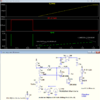No, the display and op amp electronics are in the passenger compartment.but the bridge, OP-AMP and display unit are all in the engine compartment with the AD590 and the pressure switch.
The AD590 (and pressure switch of course) are in the engine compartment.

